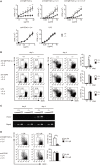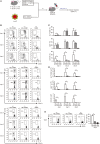The Rac Activator DOCK2 Mediates Plasma Cell Differentiation and IgG Antibody Production
- PMID: 29503648
- PMCID: PMC5820292
- DOI: 10.3389/fimmu.2018.00243
The Rac Activator DOCK2 Mediates Plasma Cell Differentiation and IgG Antibody Production
Abstract
A hallmark of humoral immune responses is the production of antibodies. This process involves a complex cascade of molecular and cellular interactions, including recognition of specific antigen by the B cell receptor (BCR), which triggers activation of B cells and differentiation into plasma cells (PCs). Although activation of the small GTPase Rac has been implicated in BCR-mediated antigen recognition, its precise role in humoral immunity and the upstream regulator remain elusive. DOCK2 is a Rac-specific guanine nucleotide exchange factor predominantly expressed in hematopoietic cells. We found that BCR-mediated Rac activation was almost completely lost in DOCK2-deficient B cells, resulting in defects in B cell spreading over the target cell-membrane and sustained growth of BCR microclusters at the interface. When wild-type B cells were stimulated in vitro with anti-IgM F(ab')2 antibody in the presence of IL-4 and IL-5, they differentiated efficiently into PCs. However, BCR-mediated PC differentiation was severely impaired in the case of DOCK2-deficient B cells. Similar results were obtained in vivo when DOCK2-deficient B cells expressing a defined BCR specificity were adoptively transferred into mice and challenged with the cognate antigen. In addition, by generating the conditional knockout mice, we found that DOCK2 expression in B-cell lineage is required to mount antigen-specific IgG antibody. These results highlight important role of the DOCK2-Rac axis in PC differentiation and IgG antibody responses.
Keywords: B cell receptor; DOCK2; Rac activation; antibody production; immunological synapse; plasma cell.
Figures






Similar articles
-
The Rac activator DOCK2 regulates natural killer cell-mediated cytotoxicity in mice through the lytic synapse formation.Blood. 2013 Jul 18;122(3):386-93. doi: 10.1182/blood-2012-12-475897. Epub 2013 May 29. Blood. 2013. PMID: 23719299
-
Selective control of type I IFN induction by the Rac activator DOCK2 during TLR-mediated plasmacytoid dendritic cell activation.J Exp Med. 2010 Apr 12;207(4):721-30. doi: 10.1084/jem.20091776. Epub 2010 Mar 15. J Exp Med. 2010. PMID: 20231379 Free PMC article.
-
Growth of B Cell Receptor Microclusters Is Regulated by PIP2 and PIP3 Equilibrium and Dock2 Recruitment and Activation.Cell Rep. 2017 Nov 28;21(9):2541-2557. doi: 10.1016/j.celrep.2017.10.117. Cell Rep. 2017. PMID: 29186690
-
Determinations of B cell fate in immunity and autoimmunity.Curr Dir Autoimmun. 2005;8:1-24. doi: 10.1159/000082084. Curr Dir Autoimmun. 2005. PMID: 15564715 Review.
-
The CDM protein DOCK2 in lymphocyte migration.Trends Cell Biol. 2002 Aug;12(8):368-73. doi: 10.1016/s0962-8924(02)02330-9. Trends Cell Biol. 2002. PMID: 12191913 Review.
Cited by
-
Insights from DOCK2 in cell function and pathophysiology.Front Mol Biosci. 2022 Sep 29;9:997659. doi: 10.3389/fmolb.2022.997659. eCollection 2022. Front Mol Biosci. 2022. PMID: 36250020 Free PMC article. Review.
-
DOCK family proteins: key players in immune surveillance mechanisms.Int Immunol. 2020 Jan 9;32(1):5-15. doi: 10.1093/intimm/dxz067. Int Immunol. 2020. PMID: 31630188 Free PMC article. Review.
-
Multiple Immune Defects in Two Patients with Novel DOCK2 Mutations Result in Recurrent Multiple Infection Including Live Attenuated Virus Vaccine.J Clin Immunol. 2023 Aug;43(6):1193-1207. doi: 10.1007/s10875-023-01466-y. Epub 2023 Mar 22. J Clin Immunol. 2023. PMID: 36947335 Free PMC article.
-
DOCK2 Promotes Atherosclerosis by Mediating the Endothelial Cell Inflammatory Response.Am J Pathol. 2024 Apr;194(4):599-611. doi: 10.1016/j.ajpath.2023.09.015. Epub 2023 Oct 12. Am J Pathol. 2024. PMID: 37838011 Free PMC article.
-
A MZB Cell Activation Profile Present in the Lacrimal Glands of Sjögren's Syndrome-Susceptible C57BL/6.NOD-Aec1Aec2 Mice Defined by Global RNA Transcriptomic Analyses.Int J Mol Sci. 2022 May 29;23(11):6106. doi: 10.3390/ijms23116106. Int J Mol Sci. 2022. PMID: 35682784 Free PMC article.
References
Publication types
MeSH terms
Substances
LinkOut - more resources
Full Text Sources
Other Literature Sources
Molecular Biology Databases
Miscellaneous

